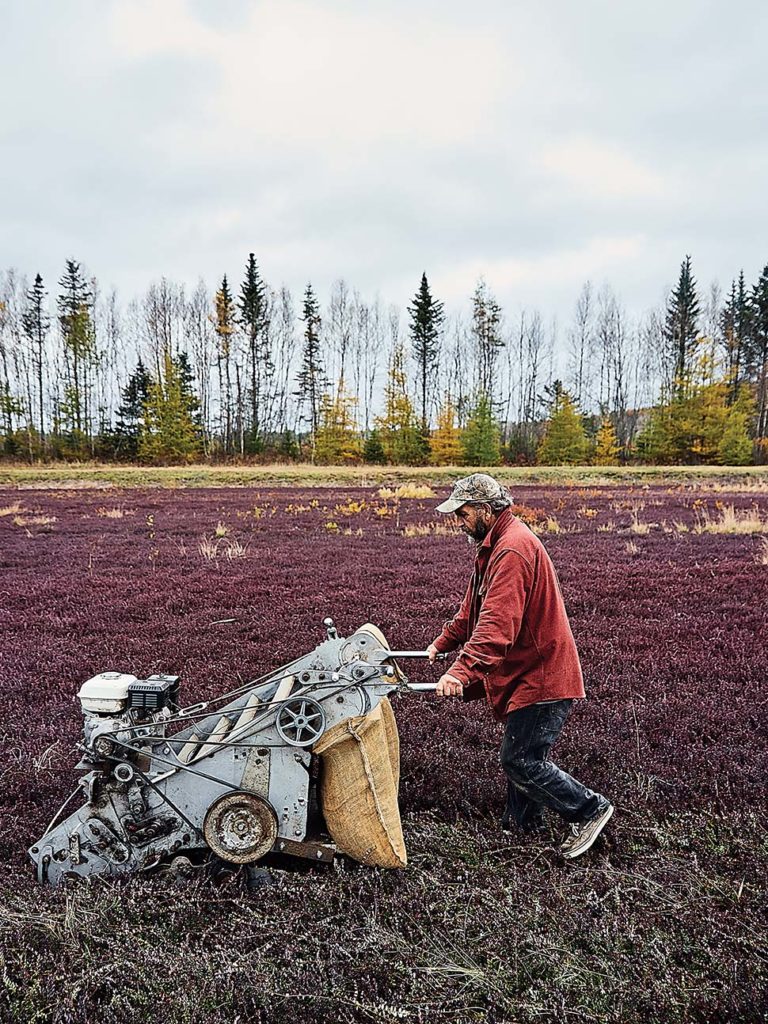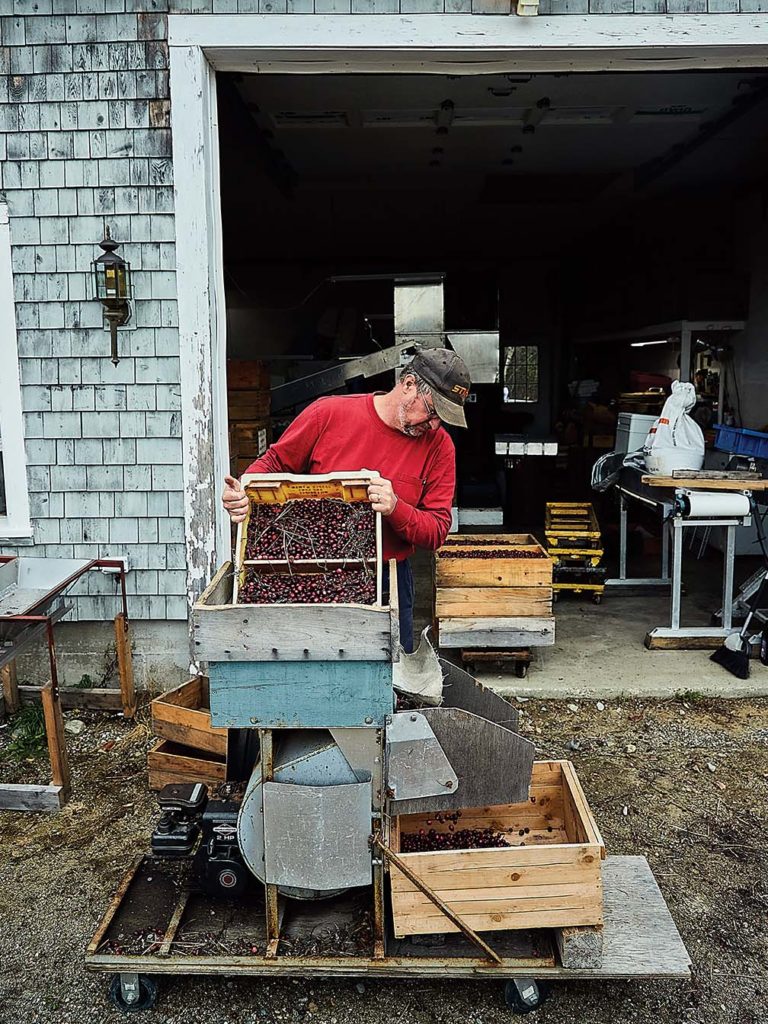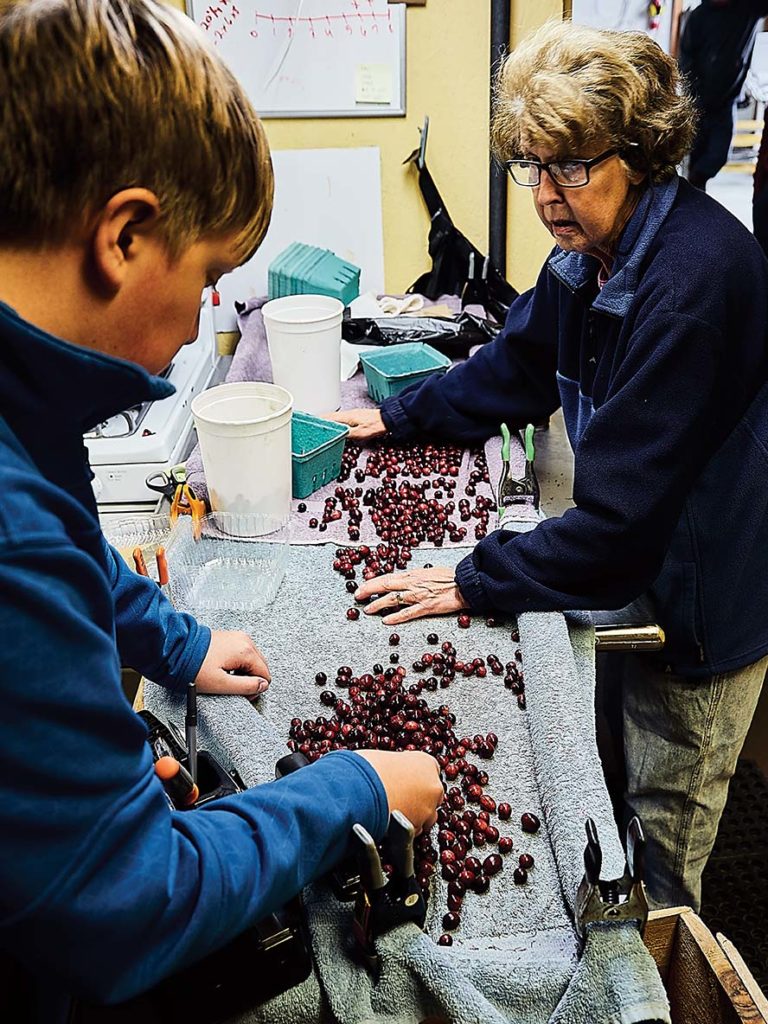The Families Preserving Maine’s Cranberry Harvesting Traditions
For generations, downeast farms have cultivated Maine’s other native wild fruit.

The Families Preserving Maine’s Cranberry Harvesting Traditions
For generations, downeast farms have cultivated Maine’s other native wild fruit.
Photography by Peter Frank Edwards
By Sandy Lang
Issue: September 2021
Color comes with the cold,” says Courtney Hammond, while standing at Lynch
Hill Farms in coastal Washington County, where he helped his parents build cranberry bogs decades ago.
It’s the third week of October, and three generations of the family are at their usual places: in the shop, in the processing shed, or outside, like Hammond is, for the fall harvest rituals. Tree leaves have fallen or are hanging on in colors of gold, garnet, and pumpkin orange. Everyone knows to keep a close watch on the thermometer this time of year. Chilly temperatures are needed for the cranberries to burnish to ruby red, but a hard freeze will damage the crop. There’s a balance, Hammond says, and they flood the fields with water as needed to protect the ripening cranberries. Picking at the proper time is essential.
“I harvested Early Black until it got so dark last night that I couldn’t see,” he says, referring to one of three harvest too. “I love this fresh air,” he says of days cranberry varieties that the farm grows, along with Pilgrim and Stevens.
Afterward, he slept in his truck beside the bogs so he could monitor the temperatures. The berries can tolerate temperatures below freezing, into the mid-20s and even lower-20s, especially as the berries redden and ripen. “We really tease out that deep red color by waiting for it to drop a degree or two before turning on the water pumps,” he says.

A canvas bag is filled during the harvest at Sugar Hill Cranberry Company. 
Ripened to a red that’s so deep it’s garnet-black sometimes, cranberries that were just-picked are stacked in crates during an October harvest in Washington County.
Hammond is wearing a red sweatshirt when we catch up with him—almost as if demonstrating the optimal berry color. In the midmorning hours, he’s surveying the nine cranberry bogs that his family cultivates at their downeast farm in Harrington, about a 50-mile drive up the coast from Ellsworth. A teenager who lives nearby is working in the nearest bog. Michael Cowland, who is wearing a black ball cap, guides a small harvesting machine with a 5.5-horsepower motor that’s controlled by walk- ing behind it. The contraption requires two hands to steady it—sort of like a shopping cart—while it chugs along and collects, rotates, and shakes berries into rectangular bins.
When he takes a break, Cowland says he’s considering becoming a farmer himself one day and that he helped with the farm’s summer blueberry harvest too. “I love this fresh air,” he says of days outside in this easternmost coastal county. Plus, he likes to munch a few cranberries along the way, before they are sugared or juiced or cooked into a sauce. “It’s something tart, and some people, they don’t like the cranberries like this. But I do—and the deer do, too.”
He points out that, since there’s no fence around the five acres of bogs, deer sightings go with the territory.

Ocean Spray, Almost
The tidal reach of Flat Bay comes within 400 yards of the cranberry and blueberry fields at Lynch Hill Farms. A sea fog often sets in, and the low tangles of cranberry vines grow and produce fruit—after pink blooms in June and July are pollinated by bees brought here in boxes each year.
Nothing’s guaranteed, though. A late-spring freeze or a long summer drought can severely impact the yields, and the 2020 season had both, resulting in a tough year for many Maine-grown crops, including about 80 percent fewer cranberries at Lynch Hill. “Farming is a gamble,” Hammond says. But he and his family have been sticking with it. They sell a variety of products besides blueberries and cranberries, including vinegars and sauces made with the berries, shiitake mushrooms, and balsam holiday wreaths.
It’s one of those sweater-weather gray days of fall. I bend down and pick a couple of the gumball-sized cranberries, polish them on my shirt, and notice the sheen of the dark red skin. They look firmly ripe. And it’s a satisfying pop when you bite into one, just moments after plucking it from the vine. I like them, too, I tell Hammond and Cowland—not too sour at all.

During the dry harvest at Lynch Hill Farms, the berries are poured into a mechanical sorter that vibrates and tumbles the berries to remove stems and leaves. 
Cranberries on the vine.
Wild History
Hammond, who also serves as president of the Maine Farm Bureau, explains that cranberries are one of the few native wild fruits in North America that are cultivated commercially—along with Concord grapes and blueberries. The low-to-the-ground vines of the American cranberry (Vaccinium macrocarpon) are found growing wild from the mountains of Georgia to the Canadian Maritimes and as far west as Minnesota, according to online resources from the University of Maine Cooperative Extension.
And the berries are intertwined with Maine history. You see them in place names, such as Cranberry Peak in the Bigelow Preserve in western Maine and the Cranberry Isles around Mount Desert Island, so-named in the 1700s because of the vast cranberry marshlands, including some 200 acres on Great Cranberry Island.
According to agricultural accounts, commercial cultivation of cranberries began around Cape Cod in the early 1800s then expanded throughout New England. Most of the Maine cranberry growing in the twentieth century was in home plots, until the state invested in resources for small cranberry growers in the late 1980s. That’s when farms like Lynch Hill got started. Courtney Hammond recalls driving a bulldozer to help his father, Robert Hammond, dig and establish the farm’s bogs.

Ashton Hammond and his grandmother, Helene Hammond, do final inspection and sorting of the cranberries. 
Ashton Hammond and Michael Cowland harvesting berries.
A Cranberry Curiosity
This to-the-source cranberry excursion by photographer Peter Frank Edwards and me was spurred a few years ago when I noticed the cranberries I’d just bought in Belfast came from a one-acre bog less than a dozen miles away, in Lincolnville Center. With a few bags of berries in hand, I found a recipe for cranberry sauce online and another for cranberry Irish soda bread (from the cookbook Saltwater Seasonings, coauthored by Jonathan Chase of Blue Hill). I got to cooking and baking. Since then, I haven’t found many cranberry recipes I don’t like. So we stock up on cranberries at Lynch Hill Farms with both fresh and canned versions.
Our next stop is another Washington County cranberry farm, the Sugar Hill Cranberry Company in Columbia Falls, at the end of winding dirt roads through the woods. Under a steely fall sky, we come to the 11 acres or so of cranberry bogs established by the founders, Christine and John Alexander. Clay and sand line the bottoms, and raised berms around the edges help to hold water for occasional flooding.
John explains that, when they use the irrigation system to flood the bogs for a wet harvest, natural air pockets inside each berry cause them to “float like bobbers.” Cranberries harvested through the wet process are processed for juice and jellies. The dry-harvest berries are sold as fresh berries, which can be stored for months or frozen. On this day, he’s using a mechanical, walk-behind harvester, similar to those at the Hammond family’s farm. During the dry harvesting at Sugar Hill, the berries are gathered into burlap bags. At the edge of the bog, I look inside an open bag to see some of the garnet-hued haul. Leaves and bits of green vine are also strewn throughout, and John explains that the fresh cranberries will be bagged by hand after going through a 1930s-era winnower that shakes off and sorts out everything but the berries.

Meanwhile, on the Sugar Hill website and social media pages, Christine Alexander regularly offers inspiration for enjoying cranberries—not just at fall and winter holidays but year-round. Her posts have included pictures of bees buzzing at the bogs, cones of cranberry ice cream, the Sugar Hill demonstration booth at the Fryeburg Fair, and upside-down cakes and cranberry squares. When we talk, the conversation quickly turns to savory recipes, including a chicken stroganoff she made recently using cranberry vinegar. I’d like to try that sometime.

Winery Walk
For one more cranberry experience on this fall junket, Peter Frank and I spend the next available sunny afternoon on a drive through the midcoast countryside toward Sweetgrass Farm Winery and Distillery, due west of Camden Hills State Park. The tasting room and shop is inside a vintage barn on a hillside with panoramic views, and there we find cranberry bitters, cranberry gin, and apple-cranberry hard cider, all made with Maine cranberries.

We buy a couple of bottles of spirits for sipping so we can continue this cranberry immersion. Peter Frank tells me he has a cocktail in mind with cranberry gin and ginger ale. I’ve already made the dough for a cranberry yeast bread with some of the fresh cranberries. (It’s rising at home.)
But first, we take in a little more of the sweet fresh air of the season. Just beyond the tasting room deck, visitors can follow trails down toward the Medomak River. We walk a while on paths past fields edged with milkweed pods that have burst open in silky threads, and we follow the downward slope to woods and the river valley.
That’s when I recall that cranberry grower John Alexander mentioned the possibility of happening upon Maine’s wild cranberries, including near scenic roadside turnouts and river bends, “if you know where to look.” Since I’ve just seen up close how cranberries twist and grow, I keep an eye out for wild vines in this landscape, but don’t see any. Later, we clink rocks glasses with a toast to the bogs and producers. And when the tree leaves start to redden and drop this year, I’ll be ready to stock up again with fresh cranberries from local growers for plenty more cookery—and cocktails, too.

Cranberry Yeast Bread
No-knead. Two rises. Start from a cold oven.
31⁄4 cups all-purpose flour
1 cup whole wheat flour (Maine Grains makes excellent flours) 2 teaspoons salt
1⁄2 teaspoon instant yeast
13⁄4 cups water
11⁄2 cups cranberries (cut each berry in half)
1 cup chopped walnuts or pecans
1. Mix the flours, salt, yeast, and water in a large bowl. Once stirred, use your hands to continue mixing the dough just enough to incorporate the flour. Work in the fruit and nuts. Cover the bowl with plastic wrap or a plate and allow to rest at room temperature overnight (at least eight hours).
2. Turn out the dough onto a lightly floured surface, and form it into a round loaf to fit a 9- to 10-inch lidded baking crock (a cast iron Dutch oven works great). Lightly grease the bottom and sides of the crock. Place the dough in, smooth side up.
3. Cover the crock and let the dough rise at room temperature for about 2 hours, until a slight indentation remains when the dough is poked. Slash the top a few times with sharp knife and place the bread in a cold oven. Set the oven to 450°F.
4. Bake for 45 minutes, then remove the lid and bake for another 5 to 10 minutes, until the bread is a deep brown color. Remove from the oven, turn out onto a cooling rack, and allow to cool completely before slicing.

Cranberry walnut bread made with freshly picked Maine cranberries 
Cranberry walnut bread made with freshly picked Maine cranberries
Cran-Everywhere
Around Maine come fall, cranberry cocktails and recipes start showing up, not only for home cooking but also on bakery and restaurant menus—everything from sweet pies and coffee cakes to savory sauces and vinegar-based concoctions. Various co-ops, grocery stores, and farm stands offer Maine-grown cranberries.
Here’s a sampler of the many sources of fresh cranberries and year-round cranberry products you can try this season:
Lynch Hill Farms, Harrington
lynchhillfarms.com
Fresh cranberries, sauce, vinegars, and baked goods.
Sweetgrass Farm Winery + Distillery, Union
sweetgrasswinery.com
Cranberry gin, cranberry-apple hard cider, cranberry bitters.
Sugar Hill Cranberry Co., Columbia Falls
sugarhillcranberries.com
Bulk cranberries.
Catherine Hill Winery, Cherryfield
catherinehillwinery.com
Wine made with Washington County cranberries.
Nervous Nellie’s Jams + Jellies, Deer Isle
nervousnellies.com
Cranberry peach chutney.
Maine Craft Distilling, Portland
mainecraftdistilling.com
Sparkling cocktail in a can with cranberry, vodka, and lime.
Ricker Hill Orchards, Turner
rickerhill.com
Cranberry-apple ciders.
Read more culture stories:
- Claiming Space at the Table

- How to Go Antiquing Like a Mainer

- Four Young Writers to Watch in the Pine Tree State

- Milkweed Man


